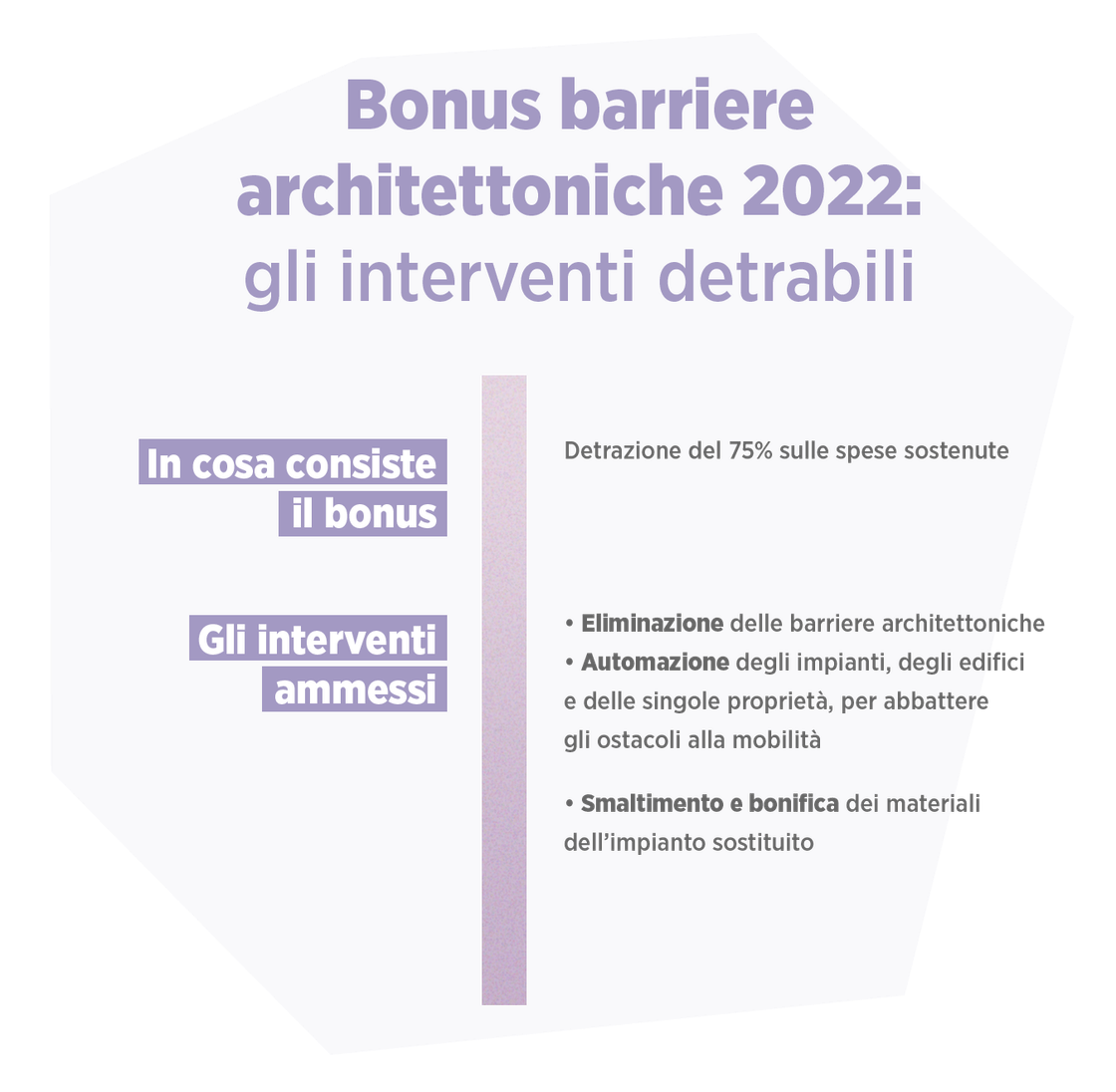Index
In addition to the extension of the building bonuses, starting from January 2022 the Budget Law provides for an additional tax relief: the architectural barrier bonus.
This support is guaranteed to all citizens who decide to carry out work on buildings and individual properties to removing obstacles that hinder mobility.
If you plan to renovate a property, the elimination of architectural barriers bonus is a tool in your favor. Find out how it works, who can request it and under what conditions in this Casavo guide.
How the architectural barriers bonus works
Introduced by Article 1, paragraph 42 of the new Budget Law, the 2022 architectural barriers bonus consists of a 75% tax deduction on expenses incurred for all interventions carried out on existing buildings in order to overcome and eliminate obstacles to mobility.
The benefit, valid for works deemed suitable carried out between January and December of the current year, is subject to some specific spending limits, as is the case for the bonus facades or the bonus prima casa. The deduction, in fact, is calculated on a total amount of:
- €50,000 for single-family properties or for independent properties located within multi-family buildings;
- €40,000 for each real estate unit that is part of a building consisting of two to eight apartments;
- €30,000 per property for buildings consisting of more than eight real estate units.
The reimbursement, paid in 5 annual installments of equal amounts, can only be obtained if no further benefits have been requested for healthcare expenses for the purchase of tools and equipment necessary for lifting disabled people. The latter is a necessary requirement to obtain the bonus for the removal of architectural barriers, but it is not the only one.
Let's proceed in order, however. First of all, it may be useful to clarify what is meant by architectural barriers and what expenses are eligible for obtaining the bonus.
What are architectural barriers
You've certainly heard of them, and they are often the subject of long ethical and political debates. But what exactly are architectural barriers?
This definition includes:
- material obstacles that impede the correct mobility of all citizens, especially those with temporarily or permanently reduced motor skills;
- obstacles that limit or make structures or parts of them inaccessible;
- the lack of indications and signals that allow orientation and recognition of places and sources of danger for all blind, visually impaired, and deaf citizens.
These conditions are valid for both urban spaces and the common areas of more or less large residential complexes.
Accessibility, therefore, seems to be the watchword that, for 2022, guides the government's decisions on construction. If this topic concerns you, it's time to understand together which expenses you can deduct.
Expenses that are eligible for the architectural barrier removal bonus
The article dedicated to construction in the 2022 Budget Law also lists the expenses eligible for the benefit, namely:
- all interventions aimed at eliminating architectural barriers;
- interventions for the automation of systems in buildings and individual properties, designed to remove obstacles to mobility;
- in the event of system replacement, the expenses incurred for the disposal and remediation of materials and the replaced system.
For example, you can request the installation of inclined ramps, elevators or lifting platforms, or adapt the restrooms to make them usable by everyone. Or, install electrical systems and intercoms by placing them at an easily accessible height.
Just remember that all these works are not deductible if they are carried out on newly built properties – which should already have these characteristics – and that it is necessary to keep track of each payment by issuing the necessary tax receipts.

What are the requirements to request the architectural barriers bonus
The 2022 architectural barriers bonus can be requested by all people who demonstrate, through invoices and receipts, that they have invested money to remove obstacles to mobility within their home or condominium, even in the absence of disabled people or elderly people over 65.
It is also necessary to certify that the interventions carried out comply with the requirements expressly set out in the decree of the Minister of Public Works n. 236/1989, and therefore guarantee:
- accessibility;
- adaptability;
- visitability of subsidized and facilitated private and public buildings.
In light of all this information, all you have to do is understand how to submit the request and what documents you need to do so correctly.
How to request the architectural barriers bonus
To request the architectural barriers elimination bonus, simply enter the 75% Irpef deduction in your tax return, dividing the total amount of the amortization into 5 annual installments.
Alternatively, you can take advantage of the benefit more quickly through:
- a discount on the invoice by of the company that carried out the work, which the company will recover in the form of a tax credit;
- the transfer of the credit of an amount equal to the deduction you are entitled to with the immediate reimbursement of 75% of what you spent.
Be careful, though! The Anti-Fraud Decree of 11 November 2021 establishes that for these two specific cases, when dealing with amounts exceeding €10,000, it is mandatory to send the Revenue Agency:
- the conformity certificate of the data relating to the documents certifying the right to request the deduction;
- proof of the congruence between expenses incurred and interventions carried out.
Thanks to the building incentives, buying and renovating a home in 2022 is more convenient than ever, and with our help it is also easy and quick. Check out the Casavo's classifieds platform: your new home could be right there waiting for you.







